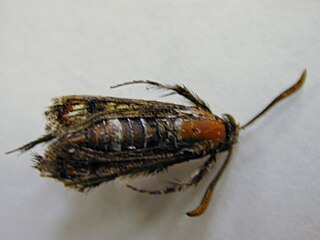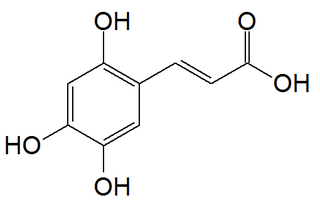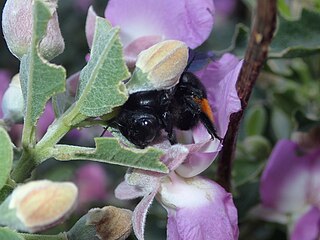
Rooibos, or Aspalathus linearis, is a broom-like member of the plant family Fabaceae that grows in South Africa's fynbos biome.

Nothofagus fusca, commonly known as red beech is a species of southern beech, endemic to New Zealand, occurring on both the North and South Island. It is generally found on lower hills and inland valley floors where soil is fertile and well drained. In New Zealand the species is called Fuscospora fusca.

The Groot Winterhoek mountains are located in the Western Cape province of South Africa and are part of the Cape Fold Belt comprising a watershed area of 552,606 hectares. They rise to a maximum height of 2077 m just north of the town of Tulbagh as Groot Winterhoek peak. The mountains are predominantly made up of Table Mountain sandstone. Up to 83% of the range is still classified as being in a natural state and up to 72% of the range is protected. The towns of Saron and Porterville are located at the foot the mountain range's western side.

Aspalathin is a C-linked dihydrochalcone glucoside found in rooibos tea, a herbal tea prepared from the South African rooibos plant, Aspalathus linearis (Fabaceae).

Nothofagin is a dihydrochalcone. It is a C-linked phloretin glucoside found in rooibos and New Zealand red beech. It is a phenolic antioxidant.

Melittia oedipus, the African vine borer, is a moth of the family Sesiidae. It originates from Africa, but has been introduced in Hawaii to control ivy gourd.

Aspalathus is a genus of flowering plants in the family Fabaceae. The yellow flowers and spiny habit of some species have suggested a resemblance to Ulex europaeus, the thorny "English gorse" Accordingly, "Cape Gorse" has been proposed as a common name although the resemblance is largely superficial; for instance, gorse is thorny, whereas Aspalathus species are variously spiny or unarmed. The genus belongs to the subfamily Faboideae. There are over 270 species, mainly endemic to southwestern fynbos regions in South Africa, with over fifty occurring on the Cape Peninsula alone. The species Aspalathus linearis is commercially important, being farmed as the source of Rooibos tea.
Austrosetia is a genus of moths in the family Sesiidae containing only one species, Austrosetia semirufa, which is known from South Africa.
Monopetalotaxis is a genus of moths in the family Sesiidae.

Swartland Shale Renosterveld is a critically endangered vegetation type of the Western Cape, South Africa.
Sura melanochalcia is a moth of the family Sesiidae. It is known from South Africa.
Monopetalotaxis chalciphora is a moth of the family Sesiidae. It is known from Malawi.
Monopetalotaxis luteopunctata is a moth of the family Sesiidae. It is known from South Africa.
Monopetalotaxis doleriformis is a moth of the family Sesiidae. It is known from South Africa.
Monopetalotaxis pyrocraspis is a moth of the family Sesiidae. It is known from South Africa.
Agriomelissa ursipes is a moth of the family Sesiidae. It is known from Somalia and South Africa.

2,4,5-Trihydroxycinnamic acid is a hydroxycinnamic acid found in rooibos tea. cis-2,4,5-Trihydroxycinnamic acid can be isolated from seeds of Alisma orientale.
Rooibos wine is a variety of wine in which wood from the rooibos and honeybush plants is used instead of the traditional oak wood during the maturation phase. It has its origin in the Western Cape, South Africa. The wine has a unique flavor component and due to the anti-oxidative effect of the plants can be produced without the use of sulfur dioxide.

Xylocopa rufitarsis is a species of carpenter bee native to South Africa. It has been assigned to the subgenus Xylomelissa. It was seen to visit flowers of a wide range of plants, many of them Fabaceae such as Acacia karroo, Aspalathus linearis, A. spinescens, Calpurnia glabrata, Lebeckia multiflora, Lebeckia sericea, peas and Tipuana tipu, but also Agave sp., Anchusa capensis, Hermannia gariepina, Lobostemon trichotomus, Moraea cookii, Populus sp., Prenia pallens, Zygophyllum morgsana, Salvia dentata and other Lamiaceae. Nests of been found in Metalasia muricata, Psoralea aphylla and Pinus sp. They are parasitized by Anthrax badius.









